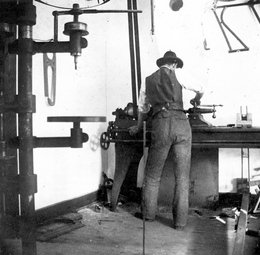
1898 -- Wilbur Wright at work in the Wright Cycle
Company, making bicycles. Note the bicycle frame overhead.
|
|
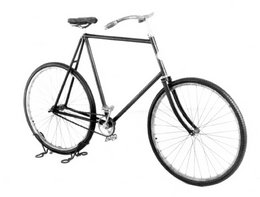
1898 -- the Wright "Van Cleve" bicycle. The Wrights
manufactured this model and one other, the "St. Clair,"
between 1896 and 1902.
|
|
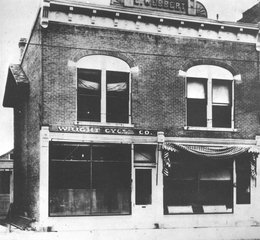
1909 -- The Wright Cycle Company at 1127
West Third Street in Dayton, Ohio. It was here that the
Wrights built all their experimental gliders and
airplanes.
|
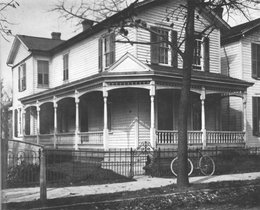
1898 -- The Wright home at 7 Hawthorne
Street in Dayton, Ohio. Both the home and the bicycle shop
were later moved to Greenfield Village at the Henry Ford
Museum in Dearborn, Michigan.
|
|
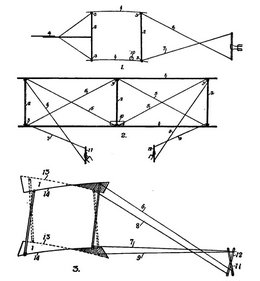
1899 -- Wilbur designed this controllable
kite to test the aerodynamic control system he would later
use in gliders and airplanes.
|
|
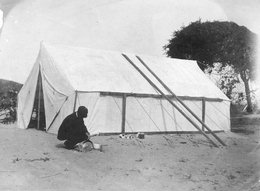
1900 -- The Wrights travel to Kitty Hawk,
North Carolina to test their first manned glider. This was
their first camp, just outside of the village. |
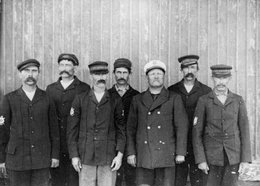
1900 -- The Lifesavers at Kitty Hawk.
These men -- in fact, many of the people on the North
Carolina Outerbanks -- aided the Wright brothers during
their visits.
|
|
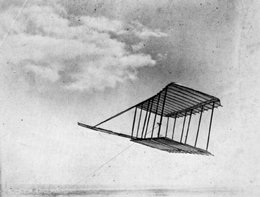
1900 -- The first Wright glider being flown as a kite to
measure its lifting capacity. The Wright found it would not
support the weight of a man in a stiff wind.
|
|
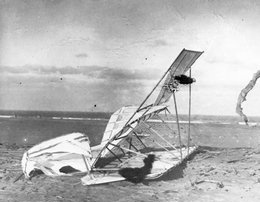
1900 -- The glider was all but destroyed when it tore loose
from the ground in a storm. The Wrights repaired it an
continued to make test flights.
|
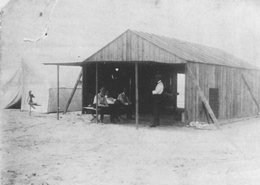
1901 -- The Wrights moved their camp to the base of the Kill
Devil Hills. Here Octave Chanute, a respected engineer and
aeronautical experimenter, visited them for the first time.
|
|
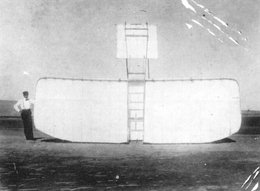
1901 -- The second Wright glider, at the time that it was
built, was the largest glider anyone had ever attempted to
fly.
|
|
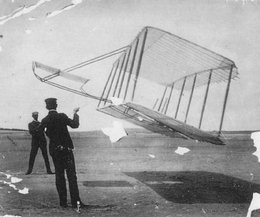
1901 -- The Wrights fly their second glider as a kite to
measure its lift. Again, they were disappointed.
|
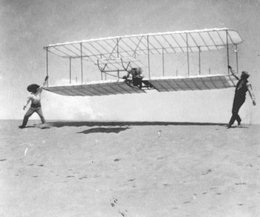
1901 -- Dan Tate and Edward Huffaker
launch Wilbur aboard the second glider. Tate was a "Banker"
(a native of the Outerbanks) and Huffaker was a friend of
Chanute's.
|
|
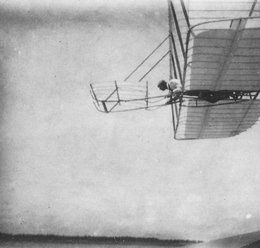
1901 -- Wilbur in flight aboard the second
glider.
|
|
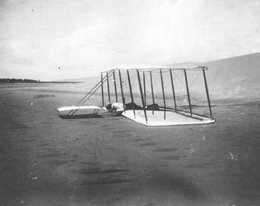
1901 -- Wilbur just after he landed. The
performance of the second glider was as disappointing as the
first, and the Wright left Kitty Hawk sooner than they had
planned.
|
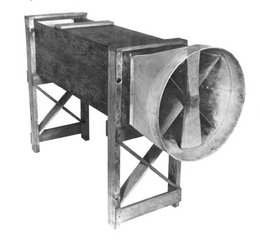
1901 -- Back in Dayton, the Wrights decided that the
information they had been relying on to design their gliders
was in error. They built this wind tunnel to test over two
hundred wing shapes and generate their own design data.
|
|
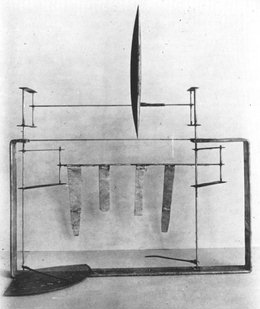
1901 -- The Wrights built several balances to use in the
wind tunnel to measure various forces on the wing shapes.
This was their "lift balance."
|
|
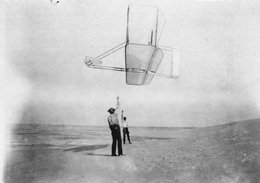
1902 -- The Wrights' third glider was designed using the
wind tunnel results. When they kited it at Kitty Hawk, they
noticed an immediate improvement in performance. Note the
double-panel tail. When the Wrights first flew this glider,
it was fixed. The tail didn't move.
|
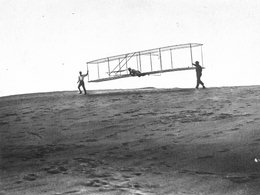
1902 -- Wilbur and Dan Tate launch Orville aboard the third
glider. The tail is now a single-panel rudder. The Wrights
made it movable to improve the controls. It is now has a
three-axis aerodynamic control system, making it the first
fully controllable flying machine ever.
|
|
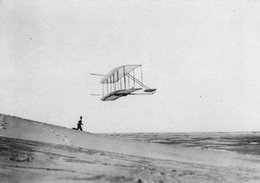
1902 -- Dan Tate chases behind Orville as he flies.
|
|
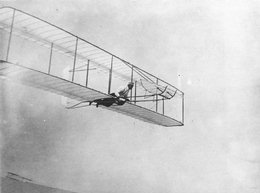
1902 -- A close-up of Wilbur as he flies the third glider.
|
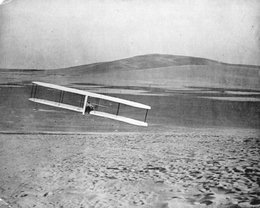
1902 -- Orville making a turn in the third glider. This
simple maneuver wasn't possible in the two previous gliders.
|
|
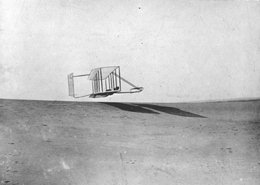
1902 -- Orville brings the glider in for a soft landing.
|
|
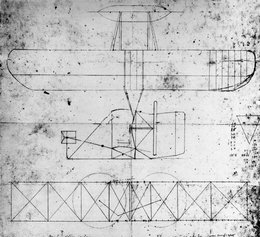
1903 -- The Wrights initial sketch for their first powered
airplane. It was drawn on brown wrapping paper.
|
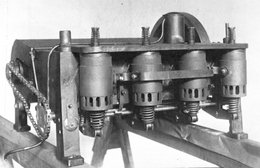
1903 -- When the Wrights couldn't find a suitable engine for
their airplane, they built their own with the help of
machinist Charley Tailor. The 200-pound, 4-cylinder engine
produced 12 horsepower.
|
|
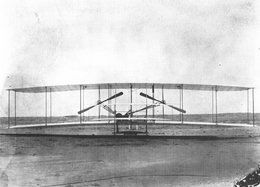
1903 -- The "Flyer," as the Wrights referred to their
airplane, was built in Dayton but was assembled for the
first time in Kitty Hawk.
|
|
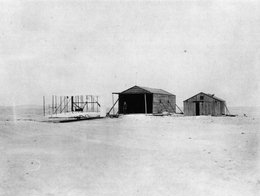
1903 -- The Wrights added another shed -- the first true
hangar -- to their camp in which to build and house the
Flyer.
|
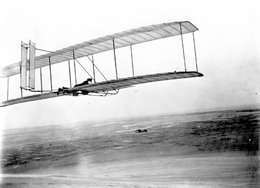
1903 -- While they were building the Flyer, they continued
to make practice flights with their 1902 glider. All total,
they made about 2000 glides.
|
|
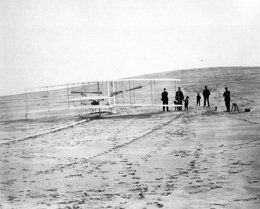
1903 -- The Wright set up the Flyer and its launch track for
the first flight attempt on December 14, 1903.
|
|
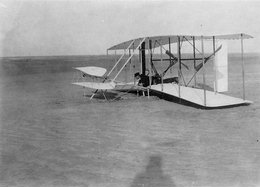
1903 -- On the first attempt to fly, Wilbur raises the nose
too high. The Flyer stalls and drops back to earth, breaking
the front skid.
|
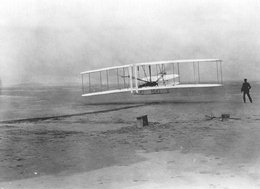
1903 -- The Wrights try again on December 17and make four
successful flights. The wind rolls the Flyer after the last
flight, damaging it beyond repair.
|
|
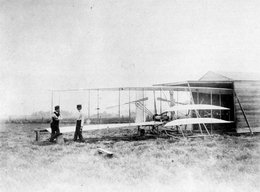
1904 -- The Wrights decide to continue their flight tests
closer to home. They build a second copy of the Flyer and
begin to test it at Huffman Prairie, near Dayton, Ohio.
|
|

1904 -- Without the winds of Kitty Hawk to help them, the
Wright have trouble getting airborne. They build a tower
that drops a weight and pulls them along the launch track,
catapulting them into the air.
|
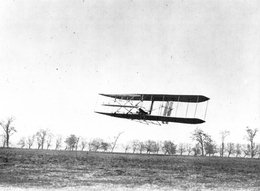
1904 -- The Wrights begin to make short flights and improve
their piloting skills. By November of 1904, they are flying
complete circles around Huffman Prairie.
|
|
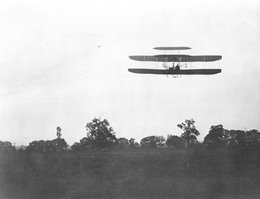
1905 -- The Wrights consider everything they've learned in
the past seven year and build their third powered airplane
-- the Wright Flyer III. It flies well and is much easier to
control than their previous Flyers. This will be their last
experimental airplane.
|
|
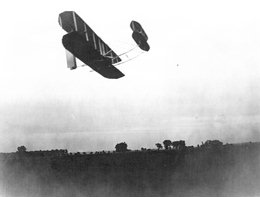
1905 -- By the end of the year, they are able to keep the
Flyer III aloft until the gas runs dry, traveling 24 miles.
They begin to look for a buyer for their airplane.
|
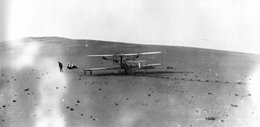
1908 -- In 1907, French industrialists and the U.S. Army
agreed to buy airplanes, provided they would carry
passengers. The Wrights outfitted their Wright Flyer III
with a new motor and two seats and took it the Kitty Hawk to
test. It was here they flew the first airplane passenger,
Charley Furnas.
|
|
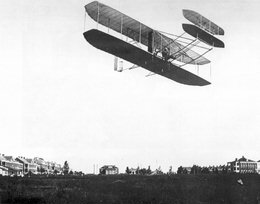
1908 -- Orville flies the Wright Military Flyer at Fort
Myer, Virginia. He begins to put the aircraft through
several "trials" to prove its performance.
|
|
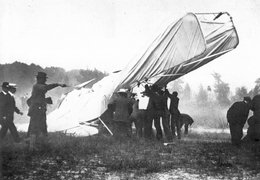
1908 -- Orville crashes during the last trial flight,
breaking his leg and hip. His passenger, Lt. Thomas
Selfridge, died of a blow to the head. The Wrights delivered
a new Flyer to the Army and completed the military trials in
1909.
|
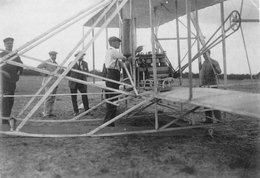
1908 -- Wilbur adjusts the engine of his airplane at Le
Mans, France. The aircraft was damaged in shipment and had
to be rebuilt entirely.
|
|
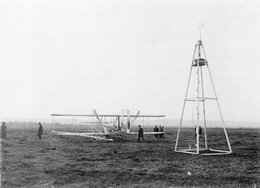
1908 -- The Wright Flyer perched upon the starting rail,
ready for take-off. Note that the weight is at the top of
the catapult tower, indicating it is "cocked."
|
|
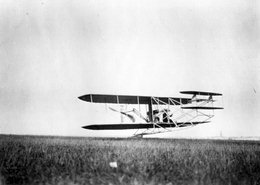
1908 -- Wilbur takes off from Le Mans, France. He, too, had
to put the aircraft through trial flights to satisfy the
French buyers.
|
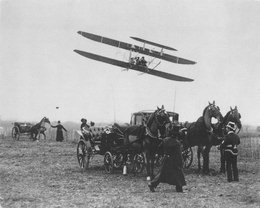
1908 -- People came from all over Europe to watch Wilbur
fly. He demonstrates the Flyer for thousands of people that
include heads of state, royalty, and the commanders of
armies.
|
|
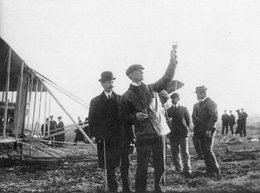
1909 -- Orville Wright, his leg and hip on the mend, joins
Wilbur in Europe.
|
|
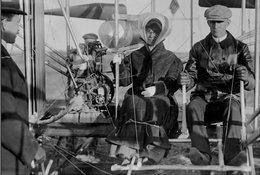
1909 -- Katharine Wright accompanies her convalescing
brother Orville and take over as the Wright social director
in Europe. Wilbur takes her aloft, making her one of the
first women to fly.
|
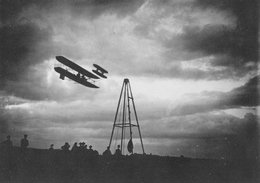
1909 -- During the winter, Wilbur moves his flight
operations to Pau in southern France. Later, he flies in
Italy, eventually making over 100 flights in Europe.
|
|
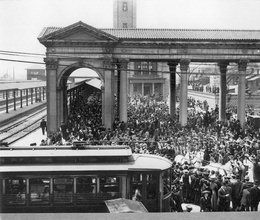
1909 -- The Wright return from Europe to a hero's welcome in
Dayton, Ohio.
|
|
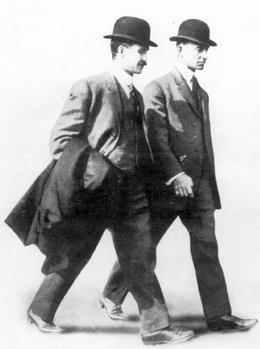
1910 -- Orville (left) and Wilbur (right), now
manufacturing two airplanes a month, attend an air meet in
Belmont, New York where they introduce their newest
airplane, the Wright Model B. The "B" will sell for $5000
each and will become the Wrights most popular model. |